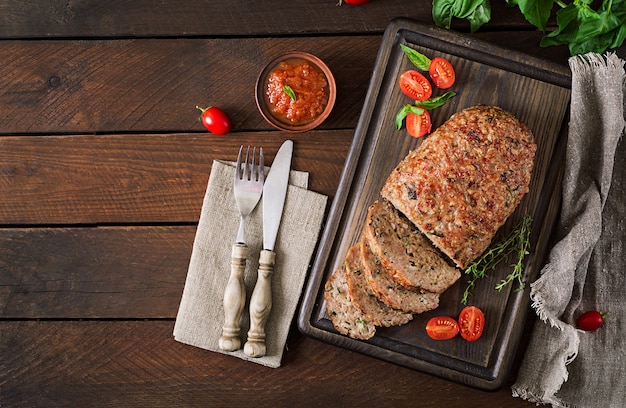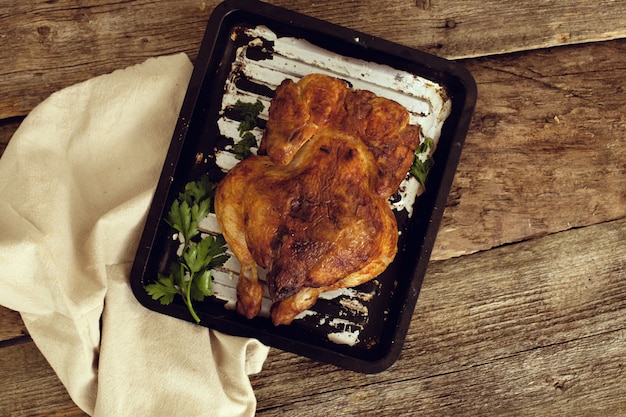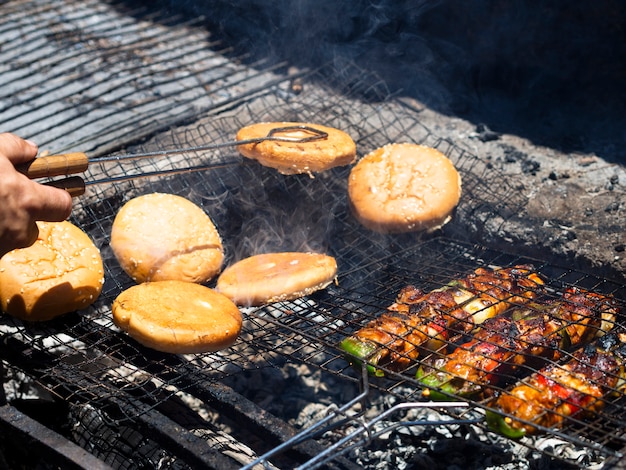Let's talk pork chops, those little bundles of juicy deliciousness! They can be a culinary triumph or a total disaster, depending on how you cook them. I've had my fair share of dry, overcooked pork chops, but trust me, I've learned a thing or two about getting them just right. This guide is all about conquering the 400-degree oven and achieving pork chop perfection. You'll learn everything from choosing the right cut and prepping them for the oven, to nailing that perfect sear and knowing when they're cooked to juicy perfection. So, grab your spatula, get ready to fire up the oven, and let's make some magic happen!
(Part 1) The Great Pork Chop Dilemma

We all crave that perfectly cooked pork chop, right? Juicy, tender, with a beautiful sear on the outside – pure culinary bliss. But achieving that magic can be a bit of a head-scratcher. I've tried every trick in the book – different cooking methods, fancy marinades, even a few whispered incantations (don't judge!), but nothing quite seemed to work consistently.
The thing is, there are so many factors at play. The thickness of the chop, the type of cut, even the quirks of your oven can make or break your pork chop dreams. But don't despair! This guide will help you navigate the complexities of cooking pork chops at 400 degrees, leading you to that glorious, juicy, and perfectly cooked pork chop you've always wanted.
The Importance of Temperature
The secret to juicy, tender pork chops is all about finding the right temperature. You need to cook them to a safe internal temperature of 145°F (63°C) to ensure they're fully cooked and safe to eat. But if you go too high, you'll end up with dry, tough pork chops – a culinary crime!
This is where the 400-degree oven comes in. It's the perfect temperature for achieving that crispy, golden sear on the outside while keeping the inside juicy and tender. I've found that 400 degrees works best for pork chops that are about 1-inch thick. If you have thicker chops, you might need to adjust the cooking time a bit, which we'll get to later on.
(Part 2) Choosing Your Pork Chops

The first step to pork chop perfection is choosing the right chops. It's a bit like picking a good wine – you need to know what you're looking for. Consider these factors when making your selection:
The Cut
There are a few different cuts of pork chops available, but here are the most common ones:
- center cut Pork Chops: These are cut from the loin, often considered the most tender and lean option. They're a great choice for grilling, pan-frying, or even baking in the oven. They're my personal favorite!
- Rib Chops: These are cut from the rib section and have a bit more fat, which gives them a richer flavor and a juicier texture. Rib chops are perfect for roasting or braising, where the fat helps to keep them moist and flavorful.
- Blade Chops: These are cut from the shoulder and are sometimes called "Boston butt" chops. They're known for being quite flavorful, thanks to their marbling, and are often used in slow-cooking methods or for making pulled pork.
Thickness Matters
When it comes to pork chops, thickness is a critical factor. Thin chops cook quickly, making them prone to drying out. Thicker chops take a bit longer, but they're better at holding onto moisture and staying juicy. For 400-degree oven cooking, I recommend chops that are about 1-inch thick. This ensures a nice, even cook while retaining that lovely juiciness.
If you find yourself with thinner chops, don't despair! You can adjust the cooking time to prevent them from drying out or consider other cooking methods like pan-frying. We'll explore these options later on.
(Part 3) The Art of Seasoning

Now that you've got your chops, it's time to get creative with seasonings! A good seasoning can truly elevate the flavor of your pork chops, transforming them from ordinary to extraordinary. I'm a firm believer in simple but effective seasoning, but feel free to experiment with your own combinations!
Here are a few of my favorite seasoning blends, but don't hesitate to experiment and try different combinations:
- Salt and Pepper: It's a classic for a reason! A generous pinch of salt and freshly ground black pepper is all you need to enhance the natural flavors of the pork.
- Garlic and Herb Blend: This is perfect for adding a burst of flavor and aroma. You can use a pre-made blend or create your own with fresh or dried herbs like rosemary, thyme, oregano, and parsley. A little bit of garlic powder or fresh garlic adds an extra depth of flavor.
- Paprika and Cumin: This combination gives your pork chops a smoky, earthy flavor that pairs beautifully with the pork. You can even add a touch of cayenne pepper for a hint of heat.
- Spicy Rub: For a kick, try a combination of paprika, chili powder, cumin, garlic powder, onion powder, and a pinch of cayenne pepper. It's a flavor explosion that's sure to please!
When it comes to seasoning, don't be shy! Generously season both sides of your pork chops. You want the seasoning to permeate the meat and infuse it with all that delicious flavor.
(Part 4) Preparing the Chops
It's time to get those chops ready for the oven. This step is all about prepping them for a perfect cook. Here's my foolproof method:
1. Pat them dry: Using paper towels, gently pat the chops dry to remove any excess moisture. This helps them brown nicely in the oven and develop a beautiful, crispy crust.
2. Season generously: Season both sides of the chops with your chosen seasoning blend, ensuring every corner is coated. Remember, don't be afraid to go heavy on the seasoning! You want it to really permeate the meat and add a bold layer of flavor.
3. Optional: For an extra burst of flavor, you can marinate the chops in advance. A simple marinade of olive oil, lemon juice, garlic, and herbs can add a depth of flavor and keep the chops incredibly juicy. Let them sit in the marinade for at least 30 minutes or up to a few hours.
4. Sear for a Crispy Crust (optional): To achieve that beautiful golden-brown crust, you can sear the chops in a hot pan before baking. It adds another layer of flavor and texture. We'll dive into searing techniques in a later part.
(Part 5) Oven Cooking Time
Now, it's time for the oven magic! This is where the 400-degree oven plays a crucial role. The cooking time will vary depending on the thickness of your chops, so it's always a good idea to use a meat thermometer to ensure they're cooked through. Remember, you want the internal temperature to reach 145°F (63°C).
Here's a general guide for cooking time, but remember, this is just a starting point. Always use a meat thermometer to ensure your chops are cooked to perfection:
| Chop Thickness | Cooking Time |
|---|---|
| 1/2-inch | 10-15 minutes |
| 3/4-inch | 15-20 minutes |
| 1-inch | 20-25 minutes |
| 1 1/2-inch | 25-30 minutes |
Remember, every oven is different. You may need to adjust the cooking time based on your oven's quirks and the specific thickness of your chops. Keep a close eye on your pork chops and use that meat thermometer like a champion.
(Part 6) The Perfect Sear
For that irresistible, golden-brown sear that elevates your pork chops to a whole new level, you'll want to preheat your oven to 400°F (204°C) and give your chops a quick sear before baking. This not only creates a beautiful crust, but it also locks in the juices for maximum tenderness.
Here's how to achieve a perfect sear:
1. Heat a large oven-safe skillet or cast iron pan over medium-high heat. A hot pan is essential for a good sear.
2. Add a tablespoon of oil to the pan, swirling it around to coat the bottom. Choose a high-heat oil like grapeseed, avocado, or peanut oil.
3. Carefully place the seasoned pork chops in the pan. They should sizzle immediately when they come in contact with the hot oil. Make sure you don’t overcrowd the pan, as this can lower the temperature and prevent a good sear.
4. Cook for about 2-3 minutes per side, or until they have a nice golden brown crust. Don't press down on the chops! Let them cook undisturbed to develop that beautiful sear.
5. Once seared, transfer the chops to a baking sheet and place them in the preheated 400°F oven. You're almost there!
(Part 7) Checking for Doneness
The chops are in the oven, the timer is set, but how do you know when they're perfectly cooked? This is where a meat thermometer becomes your best friend! It's the ultimate tool for ensuring your pork chops are cooked through without overcooking them.
Here's how to use a meat thermometer like a pro:
1. Insert the thermometer into the thickest part of the chop, making sure to avoid any bone.
2. Wait for the thermometer to stabilize. This should take about 10-15 seconds.
3. The safe internal temperature for pork is 145°F (63°C). If your chops haven’t reached this temperature, continue to cook them in the oven until they do.
4. Once your chops have reached 145°F (63°C), take them out of the oven. Don't cut into them just yet! We're going to let them rest.
(Part 8) Resting is Key
After cooking, it's essential to let your pork chops rest for 5-10 minutes before slicing and serving. Resting allows the juices to redistribute throughout the meat, resulting in unbelievably juicy and tender chops.
While the chops are resting, get your sides ready and set the table. A little patience goes a long way in creating a truly delicious and satisfying meal.
(Part 9) Serving Time
And here we are, the moment of truth! After a little rest, your pork chops are ready to be devoured. You can serve them with a variety of sides, like mashed potatoes, roasted vegetables, or a simple salad. Get creative!
I love to serve my pork chops with a side of creamy mashed potatoes and sautéed green beans. It's a classic combination that's always a winner. But don't be afraid to experiment and find your own favorite pairings!
(Part 10) FAQs
Here are some frequently asked questions about cooking pork chops in a 400-degree oven:
Q1: Can I use a different oven temperature?
A1: While 400°F (204°C) is the ideal temperature for juicy and tender pork chops, you can certainly adjust the temperature based on your preference. If you want a crispier crust, you can try cooking at a higher temperature like 425°F (220°C). Just be sure to check the chops frequently and adjust the cooking time accordingly.
Q2: What if my pork chops are too thin?
A2: If you have thin pork chops, you can still cook them in a 400-degree oven, but you'll need to adjust the cooking time. Thin chops tend to cook more quickly and can easily dry out. Start by checking them after about 10 minutes and continue to cook them in 2-3 minute intervals until they reach an internal temperature of 145°F (63°C).
Q3: Can I cook pork chops from frozen?
A3: It's not recommended to cook pork chops from frozen in a 400-degree oven. They will take much longer to cook and may not cook evenly. For best results, defrost the chops in the refrigerator overnight before cooking.
Q4: Can I add a sauce to my pork chops?
A4: Absolutely! You can add a sauce to your pork chops after they're cooked. A simple pan sauce made with wine, broth, and herbs can really elevate the flavor of your chops. You can also use a store-bought sauce, or try a recipe for your favorite pork chop sauce.
Q5: What are some tips for keeping pork chops juicy?
A5: Here are a few tips for keeping pork chops juicy:
- Don't overcrowd the pan when searing the chops.
- Use a meat thermometer to check for doneness.
- Let the chops rest for 5-10 minutes before slicing and serving.
There you have it! My guide to achieving perfect pork chops in a 400-degree oven. With a little practice and these tips, you can master the art of cooking pork chops to juicy, tender perfection. And remember, the key is to have fun and enjoy the process! Happy cooking!
Everyone is watching

Prime Rib Roast Cooking Time Chart: Per Pound Guide
Cooking TipsPrime rib roast. Just the name conjures images of lavish dinners, crackling fires, and hearty laughter. It’s ...

How Long to Bake Potatoes in the Oven (Perfect Every Time)
Cooking TipsBaked potatoes are a staple in my kitchen. They're incredibly versatile, delicious, and surprisingly easy to m...

Perfect Rice Every Time: The Ultimate Guide to Cooking Rice
Cooking TipsAs a self-proclaimed foodie, I've always been a bit obsessed with rice. It's the foundation of countless cuisi...

The Ultimate Guide to Cooking Asparagus: Tips, Techniques, and Recipes
Cooking TipsAsparagus. The mere mention of this spring delicacy conjures up images of vibrant green spears, crisp and burs...

Ultimate Guide to Cooking the Perfect Thanksgiving Turkey
Cooking TipsThanksgiving. Just the word conjures up images of overflowing tables laden with delicious food, the scent of r...
